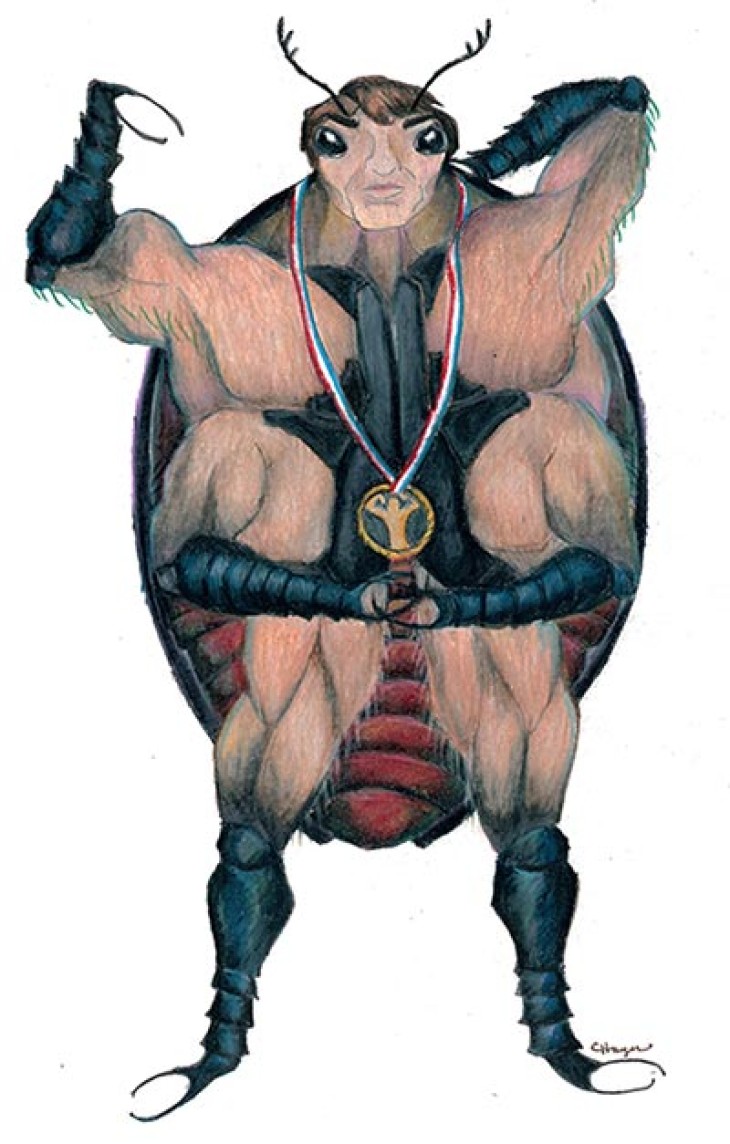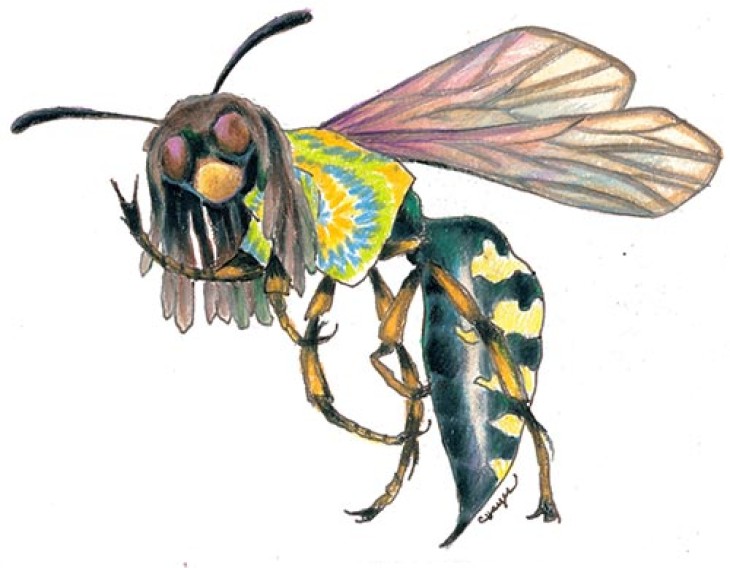
I first heard about hairy-chested yeti crabs while driving home one night, listening to NPR. Robert Siegel was interviewing Alex Rogers, an Oxford biologist. Rogers led a research team that discovered these crabs (and some dozen other new species) two miles beneath the surface of the Antarctic Ocean. The radio voices were enjoying a laugh about how the team had nicknamed them Hoff crabs after David Hasselhoff, a Baywatch star notorious for baring his own hairy chest, when Siegel asked seriously, “Well, if it’s a new species, can Hasselhoffia somehow make it into the name?” To which Rogers answered, with equal seriousness, “I’ll have to talk to my colleagues.” Rogers’ reply is more than idle banter. Indeed, it is quite possible that Kiwa hasselhoffi might just make it as the official name of this shaggy crustacean.
There is a prevailing myth out there that this kind of lightheartedness never mixes with the stuffy, carefully controlled world of science – particularly in the seemingly obtuse field of classification and naming. But as the story of the Hoff crab suggests, there is more here than mere drudgery. There is a certain undeniable poetry and playfulness to the task of naming things. But myths about scientific names abound – that they are difficult to understand, that they are an amateurish pursuit compared to “real” biology, that the work of naming creatures has already been completed, and most perniciously that using scientific names is tedious, boring, and (dare I say it) nerdy. In this article I endeavor to expose some of these myths for what they are.
Myth no. 1: Scientific names are drab.
If Hasselhoff is immortalized as the namesake of some curious shellfish, he won’t be the first celebrity to share his moniker with a creeping creature. Harrison Ford shares his with an ant, Pheidole harrisonfordi. A beetle with bulging forearms is called Agra schwarzeneggeri. Many an entomologist has graced a fetching beetle with a name based on his wife’s or girlfriend’s. Slime mold beetles have been named in supposed honor of George Bush, Dick Cheney, and Donald Rumsfeld (Agathidium bushi, A. cheneyi, and A. rumsfeldi respectively) – to the delight of Democrats.
Some names challenge modesty. Phallus daemonicum is the name of a particularly suggestive, and intimidating, stinkhorn fungus. Labium minor is, I hope unintentionally, an earwig. Other names are the wordplays you’d expect from geeky laboratory dwellers: Ytu brutus (a beetle), Lalapa lusa (a wasp for concert lovers), and Ba humbugi (a snail from Fiji that must dislike Christmas). Unfortunately, one of my favorite clams, Abra cadabra, has been renamed in the genus Theora. And La cucaracha isn’t actually a cockroach. It’s a moth. I could go on (probably for the duration of the article) but will spare you. The point is that, whether through intentional cleverness or happy accident, scientific names are fun to read.
Myth no. 2: Scientific names are difficult to understand.
Some people are under the impression that scientific names are hard to understand. After all, they are in Latin, aren’t they? Isn’t that a dead language that no one reads anymore? Still, as intimidating as scientific names may seem to the uninitiated, anyone can learn the few simple rules involved in their use. My daughter is three and she already uses dozens of them. As much as I would like to think she is some kind of naturalist prodigy, the truth is that thousands of kids her age know and use scientific names with as much aplomb. My daughter’s first scientific name? Tyrannosaurus rex. Yes, dinosaurs are referred to by their scientific names by kids and scientists around the world.
Using scientific names is no more difficult than using the names of the people around you. Scientific names have two parts, just like personal names. In English, last names identify the family to which a person belongs. Part of a scientific name also identifies a group, the genus, to which the creature belongs. Handily enough this is called the generic name. Unlike a surname, your first name is specific to you. George Foreman’s family aside, it is unlikely that you share your personal name with your siblings. Similarly, the other part of a scientific name is specific to a particular creature. Just as handily, this name is called the specific or species name. The major difference between a personal name and a scientific one is the order of the two names. In scientific names, the group name (generic name) comes first and the specific name is written second. So, if I were to change my name (Ben Lord) to the scientific style, I would write it as Lord Ben. (Gee, that has a nice ring to it.)
There are a few other changes I would have to make before my name passed scientific muster, though. In scientific names only the genus name is capitalized (Lord ben). Also, scientific names are made to stand out by using some kind of distinctive text. Usually they are italicized, but they can be in bold or underlined – thus, Lord ben. That’s all there is to it: genus first (capitalized), species second (not capitalized), both italicized. That little bit of knowledge is enough to get you through the lion’s share of scientific names you might see in print.
Myth no. 3: Scientific names are Latin.
Scientific names are often called Latin names, but this is not quite true. Yes, many of these names do come from Latin roots, but names are just as likely to be drawn from Greek. As already discussed, many names are completely contrived or constructed from places or people. It would be more accurate to call these words Latinized, rather than Latin, for scientific names are all written with Latin letters and grammar.
As pretentious as all this Latinizing might seem, it is eminently useful to have a single common system in our world of diverse languages and cultures. Each name must be unique, so that no two species can be confused. Yet once a name is applied, it becomes the accepted name for that species throughout the world. In a world where it seems that humans can hardly come to agreement on any important issue (capital punishment, Red Sox or Yankees, toilet seat up or down), what a triumph that we have agreed on some neutral territory in which we can all discuss our fellow creatures.
Myth no. 4: Scientific naming is a done deal.
To the Europeans of the 1500s, it may have seemed that the number of organisms on the planet was limited enough to be manageably codified – that a comprehensive list of all creatures, great and small, might someday be compiled. But as the influence of Europe expanded during the Age of Exploration, so did the task of naming. Strange creatures from new continents began filling the halls of European museums. Thousands of species, previously unknown, seemed to defy categorization. Dozens of different classification systems were put forth, each reflecting the proclivities and idiosyncrasies of its maker. With little overlap between them and abundant incompatibilities, it seemed by the 1700s that no sensible, universal system could be made. To make things more confusing, species were not so much named as described, using a brief Latin essay that recounted the key features of the creature in question. Imagine something like the entry in a modern field guide. Europe’s old model was ill-equipped to deal with the fact that there are vastly more creatures in the world than had previously been assumed.
Onto this stage stepped a Swedish botanist named Karl von Linné who, among many peculiar fascinations ranging from religion to numerology, had become engrossed by the scandalous idea that plants reproduce sexually the same way that animals do. Linné’s classification system, based on the reproductive parts of flowers, quickly gained notoriety as the most useful, most sensible classification system and was soon expanded to include animals as well. The genius of his system boils down to two key elements. First, it could organize vast numbers of species into hierarchical groups. Second, it trimmed the Latin essays that described each new species to a manageable summary. Originally designed as a personal shorthand, Linné assigned each creature a two word, Latinized label – the scientific name. Many of these names remain unchanged to this day. Linné even changed his own name to its Latinized form, Carolus Linnaeus, the name by which he is known today.
In sum, scientific naming was devised to deal with unexpected diversity. This is fortunate because we seem no closer now to a comprehensive list of the Earth’s inhabitants than we were in Linnaeus’s day. It is estimated that there are a whopping 1.7 million species currently described, though no one knows for sure because there is no central inventory. To get a sense of the scale, it would take a five-foot shelf of novel-length books just to list the names of the creatures we know – without footnotes or illustrations. Speculations about just how many are out there to be found range from 8 to 100 million. In The Tempest, Miranda exclaims, “How many goodly creatures are there here!” Miranda, we haven’t got a clue. There is a lot of naming left to do.
Myth no. 5: Scientific names are a quaint holdover and have little to do with the important scientific questions of the day.
There is a disappointing trend in some circles of biology to think that natural history has gone the way of the dodo (Raphus cucullatus) and that the collecting and naming of creatures is an amateurish pursuit compared to mapping genomes or manufacturing artificial enzymes. (Imagine an enthusiastic, bearded eccentric bedecked in binoculars, pith helmet, and multipocketed vest and you begin to get the idea.)
Today, naming and classifying are about much more than just placing a verbal tag on a creature. They are the building blocks of one of the triumphs of human ingenuity – a family tree of life. Ever since Darwin proposed that Earth’s creatures may be the widely divergent members of a single family of life, scientists have struggled to organize living things into their rightful places in a single, gigantic pedigree.
And while this effort was more of an art than a science for nearly a century, today we have the tools and methods to make this grand vision a reality. New genetic evidence and a new logic of classification, called cladistics, are methodically revising (and often confirming) our hypotheses about who are cousins with whom. For Romeo and Juliet, a rose, by any other name, may smell as sweet, but Rosa carolina is a name that now represents how closely the pasture rose is related to other roses, even when their evolutionary paths turned away from each other.
As Colin Tudge points out in his book, The Variety of Life, “The prime motive of science is not to control the Universe but to appreciate it more fully.” There are few things that have enhanced my appreciation of the forest creatures around my Vermont home than the knowledge that they are my cousins. What’s in a name? Only the whole evolutionary history of a creature, from its great great grandmicrobe at the dawn of life on Earth.




Discussion *